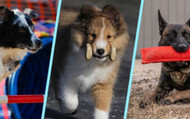Coaches at the Dog Agility World Championships
Mar 29th 2019
Agility World Championships (AWC) and the coaches
My name is Carla McAlister and my first exposure to the world team dog coaches was as an alternate for the 2016 team. And this year, 2018 I won my spot onto the team and had the full experience. I did not have any clue what the coaches did for this event until I saw it all happen. And truly, I am positive there are a million things that I didn't see happen as well. And when someone asked me after I had returned from Sweden about the coaches and what they did, I realized that maybe other people were curious about how it all worked.
Nancy is already hard at work on next years tryouts event, and planning for AWC 2019 in Finland. It is a continuous cycle of work. But for simplicity sake, let’s break it down to the time frame from tryouts at the beginning of May until dog Agility World Championships in the fall. As that is the time period when she is getting to know her new team, and doing the most active coaching.
At World Team Tryouts, she watches every run and takes notes. When the weekend is finished she then gets to review all her notes and choose the remaining team members and alternates. And of course, she makes the phone calls to impart the fabulous news of being chosen to be on the team.
There are two practices held during the summer. In preparation for the practices, the coaches track down and convert course maps from the AWC judges. During the practices, the coaches try to set up full dog agility courses so that we get the chance to practice running full courses. And the coaches give you feedback on each run. From wherever you and your dog are, they try to improve you. The practices are run by the coaches, and they also have a hand in organizing them. Which includes the travel, accommodation, and feeding of everyone attending. Approximately fifteen people from all across the United States.
They are available to consult with all summer long. Have a course map that you want to talk about, send it to them. Have video of a run that you want them to see, send it to them. They are committed to helping team members improve as much as possible. I took advantage of this availability and consulted with them on a weekly basis about making course plans from maps. I knew that if they were going to help me make the best plan possible for my dog at AWC, then we should have some experience of talking about a course from a map and making a plan.
At the event, the coaches are the information conduit between the organizers and the participants. Coaches attend the briefing that reviews rules and procedures and then relay that information to the team members. Making sure everyone shows up at the right time with the correct paperwork in hand for the vet check process. They supervise the very brief practice time that we have in the arena on the competition equipment. Making sure everyone has shown their dog any equipment that looks a little different. The coaches submit the final line up of competitors for both the team and individual events that happen at AWC. The US takes four dogs and handlers from each height to compete in the team event, results are based on the top three scores. Countries are only allowed to enter nine dogs and handlers across all heights in the individual event, so the coaches need to make decisions about who is going to run team only, and who will run both team and individual runs.
Course maps are only released just before course building begins. One of the coaches picks up the map and distributes it to the team. Team members and coaches together watch the course being built (ramps and agility tunnels) and discuss possible handling options. Once the course is built, they run a white dog, to give both the competitors and the judge an example of how the course might run. And then walk throughs start. The coach will usually take one trip around the course, and then watch team members walking. Possibly pointing out a trap obstacle. Available for asking about handling options. Will walk with you and review your plan if you want. They are on the field and available to talk to during the walk through.
They walk with you from the crating area to the arena. This may sound quite trivial, but I found the arena in Sweden to be a bit of a maze. And when you are visualizing your run, focusing on your dog and playing tug all at the same time, having a coach walking with you to make sure you don’t get lost is very important. They keep track of how many dogs until your run. Make sure you know which dog is ahead of you. They are willing to do whatever you need them to do. Including telling jokes to you while waiting in line, or not, depending on your preference. I requested that they make sure my cell phone was not in my pocket and that my sunglasses were not on top of my hat. I did not require any joke telling. They are also available to hold your toys, cookies, or jackets during your run. The coaches meet you at the exit gate with smiles and cheering.
And maybe the favorite job for the coaches is holding the flag for podium pictures when a team member does well. I would like to say a heartfelt thank you to both Nancy and Channan for helping to make my first trip to the Agility World Championships a wonderful experience that will be cherished in my memories forever.





